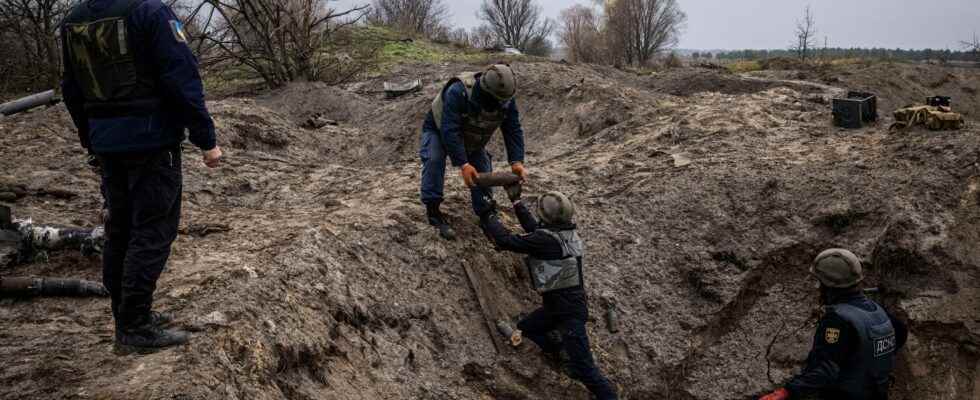War kills and wounds men, it also mutilates the earth. The effect is more pernicious, less striking than a gutted building surrounded by rubble, but very devastating. While the Russian army begins a new offensive, the Ukrainian territory shows the many scars of a year of war: charred tanks on the side of the roads or in the middle of the fields, countryside disfigured by shells and mines, forests lacerated by the passage of the trenches… The effects of the invasion on the soil of Ukraine, breadbasket of wheat and corn on the European continent, are already visible – and quantified.
Thus, according to the Ukrainian Grain Association (UGA), the cultivated area was reduced by a quarter between 2021 and 2022 due to the Russian invasion which hampered the sowing campaign. For this year, the forecasts are further revised downwards: the UGA anticipates a harvest of cereals and oilseeds of the order of 53 million tonnes in 2023, against 65 million tonnes in 2022 (and 106 in 2021) .
The passage of military vehicles and the impacts of missiles damage fertile land, “polluted by chemicals from explosive materials and fuel”, notes Vitaliy Privalov, a Ukrainian geologist who joined the GeoRessources laboratory (University of Lorraine – CNRS) in last spring. A real national treasure, the famous chernozems (literally “black earth”) are particularly concerned. “Russia has turned them into the most polluted land in the world,” says Anatolii Kucher, a professor at the Ukrainian Research Institute of Soil Science and Agrochemistry (NSC ISSAR). Rich in organic matter and minerals, Chernozems have a great capacity to absorb metals and petroleum products. Their biological properties are today degraded by the pollution of oxides of chromium, copper, nickel, lead, and petroleum coming from war material.
“Metallic compounds actively migrate underground, creating channels and traps where dangerous and toxic products for the environment accumulate. Soil absorption then reaches a saturation plateau”, explains Vitaliy Privalov, who has practiced in Donetsk until 2014 then in Dnipro. “The processes of natural detoxification and restoration of the fertility of the Chernozems are relatively slowed down, so that the purification mechanisms can last for decades or more. ‘man and animals through the food chain”, adds Kateryna Smirnova, researcher at NSC ISSAR.
“Even before the start of the Russian aggression in February 2022, in the Donbass systematically bombed since 2014, systematic overruns had been recorded chemical pollution values”, remarks the teacher-researcher of the GeoRessources laboratory. Studies carried out on the soils of the liberated territories of the Kharkiv region confirm this. In the areas where “active hostilities” took place, the levels of cadmium (4 to 18 times more), lead (3 to 22), copper (6 to 12), nickel (2 to 4) and chromium (2 to 3) were above their pre-invasion levels, according to the statements of researcher Valentina Samokhvalova (NSC ISSAR), detailed in a document that L’Express was able to consult.
“About a third of the country must be demined”
However, for arable land as for other types of soil, the long-term environmental consequences of the Russian invasion remain complex to assess as they depend on the duration and progress of the fighting. “A third of Ukraine’s forest fund, or about 3 million hectares, has already suffered from the war, estimates Vitaliy Privalov. Due to fires in oil and gas storage facilities, exploration wells , coal mines, etc., hazardous combustion products enter the air, soil and groundwater.” Not to mention the areas permanently contaminated by unexploded devices, the number of which is “greater than in Syria and Afghanistan”. “There are anti-tank and anti-personnel mines, landmines, cluster munitions and a large number of unexploded shells, lists the geologist. About a third of the country must be cleared, which will take at least ten years .”
A term exists to describe the singular form of destruction of soil resulting from the war: “bombturbation”. The concept was first introduced in 2006 by geomorphologist Joseph Hupy and geologist Randy Schaetzel. It describes the cratering of the surface of the ground and the mixing of it by the explosion of munitions and other more or less heavy artillery. Scientists looked at the case of the Verdun battlefield during World War I, where explosions fractured shallow bedrock. Changes in landscape morphology, concentration of certain metals and erosion due to the conflict are still tangible a century later. Will it be the same for Ukraine? “I would say that the term ‘bombturbation’ is much narrower than the reality caused by the Russian invasion. There is a difference in scale and use of weapons compared to the First World War. The negative impacts are much higher at present”, continues the geologist Vitaliy Privalov.
In the Donbass (east of the country), where mining activity has been intense for a long time, the soils have already undergone various alterations due to this industry. The conflict, which began in this region in 2014, has worsened the situation. The “chernozems there suffered and are still suffering irreparable military degradation. It is very difficult to overcome it”, wrote in 2021 three Ukrainian experts in an article published in an agricultural journal. Once the war is over, these territories will require “post-demining studies and detailed risk assessments, measures to accelerate the rehabilitation of soil health and special environmental monitoring”, judges Kateryna Smirnova. “Everything can be repaired, insists Vitaliy Privalov. It’s just a matter of finding the necessary funds to solve the problem.”
